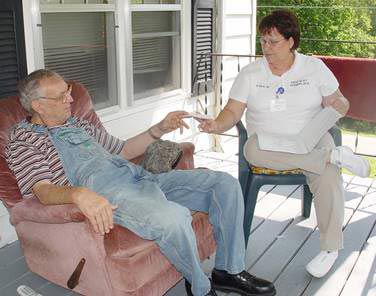Community health workers break barriers

In some Kentucky counties, people have access to community health workers (CHWs)—folks who help others navigate the healthcare system.

They’re not doctors, nurses, or social workers. They’re people from the local community who’ve learned enough about the healthcare system to serve as health coaches and can help others surmount barriers. They can also connect their clients to resources they may not have known about.
Kentucky Homeplace, a program of the UK Center for Excellence in Rural Health, serves a 30-county area of eastern Kentucky, and has been using CHWs for 21 years. Its 25 workers usually serve about 2,000 clients each quarter—a total of 110,438 since 1994.
While most Kentucky Homeplace clients are at or near the poverty line, Center Director Fran Feltner says there are no eligibility requirements—anyone with a need can get assistance. All services are free.
Feltner says clients tell CHWs things they wouldn’t say to a doctor, nurse, or social worker—for example, that they don’t have electricity or a refrigerator that can store their medicine.
A younger program that uses CHWs—“The Bridge,” or “El Puente”—has operated out of the Montgomery County Health Department’s Western Appalachian Health Care Access Network since 2006, serving Montgomery, Bath, and Menifee counties. It began as an outreach grant for the area’s Hispanic residents and later was expanded to the rest of the population.
Harold Brown is the CEO of Sterling Health Solutions in the Montgomery County seat of Mount Sterling, providing primary care services in these three counties. He says a lack of trust can be one of the biggest barriers to providing healthcare to a medically underserved community, and CHWs play a significant role in this effort by bridging cultural and language gaps.
“To have someone who is from the community, who knows them, who goes to church with them, who talks to them in the supermarket, and lives down the street from (them)—to have someone like that who is able to speak to them is critical in bridging that comfort gap,” he says.

Keisha Cornett is a community health worker who serves clients in Menifee County, where she grew up and still resides.
As a native, she says she understands the barriers to healthcare that her clients face, especially the long trips to healthcare providers. She herself has to travel 45 minutes to take her children to the pediatrician.
Cornett views much of her job as teaching her clients problem-solving skills and providing encouragement. She has a client with diabetes who had an endocrinologist’s appointment in Lexington. She called him a few days before to make sure he was planning to go, and he told her he couldn’t because he didn’t have enough money to buy gas.
Cornett says the program doesn’t offer rides or money to avoid creating “dependent behavior.” But she helped him come up with a new plan: he changed the appointment to a time when he thought he’d have money and he set up a back-up ride in case his plan fell through.
“That also served to show him things he didn’t realize about himself, such as future planning to ensure that his diabetes maintenance is successful,” she says.
There is no comprehensive directory of community health workers in Kentucky, although Montgomery County Public Health Director Jan Chamness says 400 people in the last census listed that as their profession. To find out what services are available in your county, call the local health department.
To read the health feature, “Empowering the patient,” from the November 2015 Kentucky Living magazine, click here.
James Nold Jr. UK Center for Excellence in Rural Health
